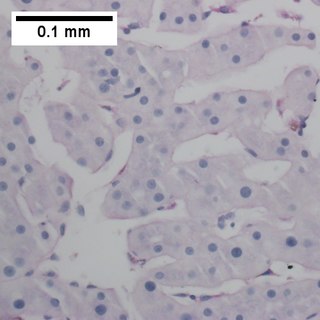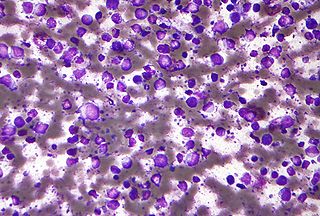Related Research Articles

The Epstein–Barr virus (EBV), formally called Human gammaherpesvirus 4, is one of the nine known human herpesvirus types in the herpes family, and is one of the most common viruses in humans. EBV is a double-stranded DNA virus. Epstein-Barr virus (EBV) is the first identified oncogenic virus, which establishes permanent infection in humans. EBV causes infectious mononucleosis and is also tightly linked to many malignant diseases. Various vaccine formulations underwent testing in different animals or in humans. However, none of them was able to prevent EBV infection and no vaccine has been approved to date.
Post-transplant lymphoproliferative disorder (PTLD) is the name given to a B cell proliferation due to therapeutic immunosuppression after organ transplantation. These patients may develop infectious mononucleosis-like lesions or polyclonal polymorphic B-cell hyperplasia. Some of these B cells may undergo mutations which will render them malignant, giving rise to a lymphoma.
Lymphoproliferative disorders (LPDs) refer to a specific class of diagnoses, comprising a group of several conditions, in which lymphocytes are produced in excessive quantities. These disorders primarily present in patients who have a compromised immune system. Due to this factor, there are instances of these conditions being equated with "immunoproliferative disorders"; although, in terms of nomenclature, lymphoproliferative disorders are a subclass of immunoproliferative disorders—along with hypergammaglobulinemia and paraproteinemias.

Primary effusion lymphoma (PEL) is classified as a diffuse large B cell lymphoma. It is a rare malignancy of plasmablastic cells that occurs in individuals that are infected with the Kaposi's sarcoma-associated herpesvirus. Plasmablasts are immature plasma cells, i.e. lymphocytes of the B-cell type that have differentiated into plasmablasts but because of their malignant nature do not differentiate into mature plasma cells but rather proliferate excessively and thereby cause life-threatening disease. In PEL, the proliferating plasmablastoid cells commonly accumulate within body cavities to produce effusions, primarily in the pleural, pericardial, or peritoneal cavities, without forming a contiguous tumor mass. In rare cases of these cavitary forms of PEL, the effusions develop in joints, the epidural space surrounding the brain and spinal cord, and underneath the capsule which forms around breast implants. Less frequently, individuals present with extracavitary primary effusion lymphomas, i.e., solid tumor masses not accompanied by effusions. The extracavitary tumors may develop in lymph nodes, bone, bone marrow, the gastrointestinal tract, skin, spleen, liver, lungs, central nervous system, testes, paranasal sinuses, muscle, and, rarely, inside the vasculature and sinuses of lymph nodes. As their disease progresses, however, individuals with the classical effusion-form of PEL may develop extracavitary tumors and individuals with extracavitary PEL may develop cavitary effusions.

Intravascular lymphomas (IVL) are rare cancers in which malignant lymphocytes proliferate and accumulate within blood vessels. Almost all other types of lymphoma involve the proliferation and accumulation of malignant lymphocytes in lymph nodes, other parts of the lymphatic system, and various non-lymphatic organs but not in blood vessels.

Diffuse large B-cell lymphoma (DLBCL) is a cancer of B cells, a type of lymphocyte that is responsible for producing antibodies. It is the most common form of non-Hodgkin lymphoma among adults, with an annual incidence of 7–8 cases per 100,000 people per year in the US and UK. This cancer occurs primarily in older individuals, with a median age of diagnosis at ~70 years, although it can occur in young adults and, in rare cases, children. DLBCL can arise in virtually any part of the body and, depending on various factors, is often a very aggressive malignancy. The first sign of this illness is typically the observation of a rapidly growing mass or tissue infiltration that is sometimes associated with systemic B symptoms, e.g. fever, weight loss, and night sweats.

Aggressive NK-cell leukemia is a disease with an aggressive, systemic proliferation of natural killer cells and a rapidly declining clinical course.
Angioimmunoblastic T-cell lymphoma is a mature T-cell lymphoma of blood or lymph vessel immunoblasts characterized by a polymorphous lymph node infiltrate showing a marked increase in follicular dendritic cells (FDCs) and high endothelial venules (HEVs) and systemic involvement.
Richter's transformation (RT), also known as Richter's syndrome, is the conversion of chronic lymphocytic leukemia (CLL) or its variant, small lymphocytic lymphoma (SLL), into a new and more aggressively malignant disease. CLL is the circulation of malignant B lymphocytes with or without the infiltration of these cells into lymphatic or other tissues while SLL is the infiltration of these malignant B lymphocytes into lymphatic and/or other tissues with little or no circulation of these cells in the blood. CLL along with its SLL variant are grouped together in the term CLL/SLL.
X-linked lymphoproliferative disease is a lymphoproliferative disorder, usually caused by SH2DIA gene mutations in males. XLP-positive individuals experience immune system deficiencies that render them unable to effectively respond to the Epstein-Barr virus (EBV), a common virus in humans that typically induces mild symptoms or infectious mononucleosis (IM) in patients. There are two currently known variations of the disorder, known as XLP1 and XLP2. XLP1 is estimated to occur in approximately one in every million males, while XLP2 is rarer, estimated to occur in one of every five million males. Due to therapies such as chemotherapy and stem cell transplants, the survival rate of XLP1 has increased dramatically since its discovery in the 1970s.
There are several forms of Epstein–Barr virus (EBV) infection. These include asymptomatic infections, the primary infection, infectious mononucleosis, and the progression of asymptomatic or primary infections to: 1) any one of various Epstein–Barr virus-associated lymphoproliferative diseases such as chronic active EBV infection, EBV+ hemophagocytic lymphohistiocytosis, Burkitt's lymphoma, and Epstein–Barr virus positive diffuse large B-cell lymphoma, not otherwise specified); 2) non-lymphoid cancers such as Epstein–Barr virus associated gastric cancer, soft tissue sarcomas, leiomyosarcoma, and nasopharyngeal cancers; and 3) Epstein–Barr virus-associated non-lymphoproliferative diseases such as some cases of the immune disorders of multiple sclerosis and systemic lupus erythematosis and the childhood disorders of Alice in Wonderland Syndrome and acute cerebellar ataxia.

Hydroa vacciniforme (HV) is a very rare, chronic photodermatitis-type skin condition with usual onset in childhood. It was first described in 1862 by Pierre-Antoine-Ernest Bazin. It is sometimes called "Bazin's hydroa vacciniforme". A study published in Scotland in 2000 reviewed the cases of 17 patients and estimated a prevalence of 0.34 cases per 100,000 population. In this study they reported an average age of onset of 7.9 years. Frequently the rash first appeared in the spring or summer months and involved sun-exposed skin. The rash starts as a vesicular eruption, later becoming umbilicated, and results in vacciniform scarring. It is most frequently found on the nose, cheeks, ears, dorsum of the hand, and arms.

Extranodal NK/T-cell lymphoma, nasal type (ENKTCL-NT) is a rare type of lymphoma that commonly involves midline areas of the nasal cavity, oral cavity, and/or pharynx At these sites, the disease often takes the form of massive, necrotic, and extremely disfiguring lesions. However, ENKTCL-NT can also involve the eye, larynx, lung, gastrointestinal tract, skin, and various other tissues. ENKTCL-NT mainly affects adults; it is relatively common in Asia and to lesser extents Mexico, Central America, and South America but is rare in Europe and North America. In Korea, ENKTCL-NT often involves the skin and is reported to be the most common form of cutaneous lymphoma after mycosis fungoides.

Peripheral T-cell lymphoma not otherwise specified (PTCL-NOS), is a subtype of peripheral T-cell lymphoma. Peripheral T-cell lymphoma (PTCL) is defined as a diverse group of aggressive lymphomas that develop from mature-stage white blood cells called T-cells and natural killer cells. PTCL is a type of non-Hodgkin's lymphoma (NHL). PTCL specifically affects T-cells rather than B-cells, and results when T-cells develop and grow abnormally.
Lethal midline granuloma (LMG) is an historical term for a condition in which necrotic and highly destructive lesions develop progressively in the middle of the face, principally the nose and palate. Many cases presented with ulcerations in or perforations of the palate.

Plasmablastic lymphoma (PBL) is a type of large B-cell lymphoma recognized by the World Health Organization (WHO) in 2017 as belonging to a subgroup of lymphomas termed lymphoid neoplasms with plasmablastic differentiation. The other lymphoid neoplasms within this subgroup are: plasmablastic plasma cell lymphoma ; primary effusion lymphoma that is Kaposi's sarcoma-associated herpesvirus positive or Kaposi's sarcoma-associated Herpesvirus negative; anaplastic lymphoma kinase-positive large B-cell lymphoma; and human herpesvirus 8-positive diffuse large B-cell lymphoma, not otherwise specified. All of these lymphomas are malignancies of plasmablasts, i.e. B-cells that have differentiated into plasmablasts but because of their malignant nature: fail to differentiate further into mature plasma cells; proliferate excessively; and accumulate in and injure various tissues and organs.
Chronic active EBV infection or in its expanded form, chronic active Epstein–Barr virus infection is a very rare and often fatal complication of Epstein–Barr virus (EBV) infection that most often occurs in children or adolescents of Asian or South American lineage, although cases in Hispanics, Europeans and Africans have been reported. It is classified as one of the Epstein-Barr virus-associated lymphoproliferative diseases.
Epstein–Barr virus–associated lymphoproliferative diseases are a group of disorders in which one or more types of lymphoid cells, i.e. B cells, T cells, NK cells, and histiocytic-dendritic cells, are infected with the Epstein–Barr virus (EBV). This causes the infected cells to divide excessively, and is associated with the development of various non-cancerous, pre-cancerous, and cancerous lymphoproliferative disorders (LPDs). These LPDs include the well-known disorder occurring during the initial infection with the EBV, infectious mononucleosis, and the large number of subsequent disorders that may occur thereafter. The virus is usually involved in the development and/or progression of these LPDs although in some cases it may be an "innocent" bystander, i.e. present in, but not contributing to, the disease.
Natural killer cell enteropathy, also termed NK cell enteropathy (NKCE), and a closely related disorder, lymphomatoid gastropathy (LG), are non-malignant diseases in which one type of lymphocyte, the natural killer cell, proliferates excessively in the gastrointestinal tract. This proliferation causes red, sore-like spots, raised lesions, erosions, and ulcers in the mucosal layer surrounding the GI tract lumen. Both disorders cause either no or only vague symptoms of GI tract disturbances such as nausea, vomiting, and bleeding.
Tabelecleucel, sold under the brand name Ebvallo, is a medication used for the treatment of Epstein-Barr virus positive post-transplant lymphoproliferative disease. Tabelecleucel is an allogeneic, EBV-specific T-cell immunotherapy which targets and eliminates EBV-infected cells in a human leukocyte antigen (HLA)-restricted manner. It is made of cells of the immune system called T-cells that have been taken from the recipient (allogeneic) and are then mixed with EBV-infected B-cells from the same donor.
References
- ↑ Liebow, Averill A.; Carrington, Charles R.B.; Friedman, Paul J. (1972). "Lymphomatoid granulomatosis". Human Pathology. 3 (4): 457–558. doi:10.1016/S0046-8177(72)80005-4. PMC 1518397 . PMID 4638966.
- ↑ Song, Joo Y.; Pittaluga, Stefania; Dunleavy, Kieron; Grant, Nicole; White, Therese; Jiang, Liuyan; Davies-Hill, Theresa; Raffeld, Mark; Wilson, Wyndham H.; Jaffe, Elaine S. (2015). "Lymphomatoid Granulomatosis—A Single Institute Experience". The American Journal of Surgical Pathology. 39 (2): 141–56. doi:10.1097/PAS.0000000000000328. PMC 4293220 . PMID 25321327.
- ↑ Tacke, Zwanique C. A.; Eikelenboom, M. Judith; Vermeulen, R. Jeroen; Van Der Knaap, Marjo S.; Euser, Anne M.; Van Der Valk, Paul; Kaspers, Gertjan J. L. (2014). "Childhood Lymphomatoid Granulomatosis: A Report of 2 Cases and Review of the Literature". Journal of Pediatric Hematology/Oncology. 36 (7): e416–22. doi:10.1097/MPH.0000000000000090. PMID 24390446. S2CID 11047705.
- 1 2 Katzenstein, Anna-Luise A.; Doxtader, Erika; Narendra, Sonia (2010). "Lymphomatoid Granulomatosis". The American Journal of Surgical Pathology. 34 (12): e35–48. doi:10.1097/PAS.0b013e3181fd8781. PMID 21107080. S2CID 41027533.
- ↑ Rezk SA, Zhao X, Weiss LM (September 2018). "Epstein-Barr virus (EBV)-associated lymphoid proliferations, a 2018 update". Human Pathology. 79: 18–41. doi:10.1016/j.humpath.2018.05.020. PMID 29885408. S2CID 47010934.
- 1 2 Ochi, N.; Yamane, H.; Yamagishi, T.; Monobe, Y.; Takigawa, N. (2013). "Methotrexate-Induced Lymphoproliferative Disease: Epstein-Barr Virus-Associated Lymphomatoid Granulomatosis". Journal of Clinical Oncology. 31 (20): e348–50. doi: 10.1200/JCO.2012.46.2770 . PMID 23733760.
- 1 2 Blanchart, K; Paciencia, M; Seguin, A; Chantepie, S; Du Cheyron, D; Charbonneau, P; Galateau-Salle, F; Terzi, N (2014). "Fatal pulmonary lymphomatoid granulomatosis in a patient taking methotrexate for rheumatoid arthritis". Minerva Anestesiologica. 80 (1): 119–20. PMID 23857444.
- ↑ Oiwa, Hiroshi; Mihara, Keichiro; Kan, Takanobu; Tanaka, Maiko; Shindo, Hajime; Kumagai, Kazuhiko; Sugiyama, Eiji (2014). "Grade 3 Lymphomatoid Granulomatosis in a Patient Receiving Methotrexate Therapy for Rheumatoid Arthritis". Internal Medicine. 53 (16): 1873–5. doi: 10.2169/internalmedicine.53.2593 . PMID 25130128.
- ↑ Yamakawa, T; Kurosawa, M; Yonezumi, M; Suzuki, S; Suzuki, H (2014). "メトトレキサート中止と脳病変への放射線照射が奏効したメトトレキサート関連リンパ腫様肉芽腫症" [Methotrexate-related lymphomatoid granulomatosis successfully treated with discontinuation of methotrexate and radiotherapy to brain]. Rinsho Ketsueki (in Japanese). 55 (3): 321–6. doi:10.11406/rinketsu.55.321. PMID 24681935.
- ↑ Kobayashi, Shinichi; Kikuchi, Yuichi; Sato, Kimiya; Matsukuma, Susumu; Matsuki, Yasunori; Horikoshi, Hideyuki; Nagumo, Morichika; Kobayashi, Ayako; Masuoka, Kazuhiro; Kimura, Fumihiko; Oshima, Satoshi; Hakozaki, Yukiya; Kondo, Toshiro (2013). "Reversible iatrogenic, MTX-associated EBV-driven lymphoproliferation with histopathological features of a lymphomatoid granulomatosis in a patient with rheumatoid arthritis". Annals of Hematology. 92 (11): 1561–4. doi:10.1007/s00277-013-1741-1. PMID 23529185. S2CID 26750255.
- ↑ Inaba, M; Ushijim, S; Hirata, N; Saisyoji, T; Kitaoka, M; Yoshinaga, T (2011). "Methotrexate-related lymphomatoid granulomatosis in a patient with rheumatoid arthritis". Nihon Kokyuki Gakkai Zasshi. 49 (8): 597–601. PMID 21894776.
- ↑ Schalk, Enrico; Krogel, Christian; Scheinpflug, Katrin; Mohren, Martin (2009). "Lymphomatoid Granulomatosis in a Patient with Rheumatoid Arthritis Receiving Methotrexate: Successful Treatment with the Anti-CD20 Antibody Mabthera". Onkologie. 32 (7): 440–1. doi: 10.1159/000218356 . PMID 19556825.
- ↑ Shimada, K.; Matsui, T.; Kawakami, M.; Nakayama, H.; Ozawa, Y.; Mitomi, H.; Tohma, S. (2007). "Methotrexate‐related lymphomatoid granulomatosis: A case report of spontaneous regression of large tumours in multiple organs after cessation of methotrexate therapy in rheumatoid arthritis". Scandinavian Journal of Rheumatology. 36 (1): 64–7. doi:10.1080/03009740600902403. PMID 17454938. S2CID 41605244.
- ↑ Kameda, Hideto; Okuyama, Ayumi; Tamaru, Jun-Ichi; Itoyama, Shinji; Iizuka, Atsushi; Takeuchi, Tsutomu (2007). "Lymphomatoid granulomatosis and diffuse alveolar damage associated with methotrexate therapy in a patient with rheumatoid arthritis". Clinical Rheumatology. 26 (9): 1585–9. doi:10.1007/s10067-006-0480-2. PMID 17200802. S2CID 21583991.
- ↑ Barakat, Athar; Grover, Karan; Peshin, Rohit (2014). "Rituximab for pulmonary lymphomatoid granulomatosis which developed as a complication of methotrexate and azathioprine therapy for rheumatoid arthritis". SpringerPlus. 3: 751. doi: 10.1186/2193-1801-3-751 . PMC 4320142 . PMID 25674479.
- ↑ Connors, William; Griffiths, Cameron; Patel, Jay; Belletrutti, Paul J (2014). "Lymphomatoid granulomatosis associated with azathioprine therapy in Crohn disease". BMC Gastroenterology. 14: 127. doi: 10.1186/1471-230X-14-127 . PMC 4105046 . PMID 25022612.
- 1 2 Roschewski, Mark; Wilson, Wyndham H. (2012). "Lymphomatoid Granulomatosis". The Cancer Journal (Submitted manuscript). 18 (5): 469–74. doi:10.1097/PPO.0b013e31826c5e19. PMID 23006954. S2CID 8958101.
- ↑ Boone, J. M.; Zhang, D; Fan, F (2013). "Lymphomatoid granulomatosis: A case report with unique clinical and histopathologic features". Annals of Clinical and Laboratory Science. 43 (2): 181–5. PMID 23694794.
- ↑ Tagliavini, E; Rossi, G; Valli, R; Zanelli, M; Cadioli, A; Mengoli, M. C.; Bisagni, A; Cavazza, A; Gardini, G (2013). "Lymphomatoid granulomatosis: A practical review for pathologists dealing with this rare pulmonary lymphoproliferative process" (PDF). Pathologica. 105 (4): 111–6. PMID 24466760.
- 1 2 Dunleavy, Kieron; Roschewski, Mark; Wilson, Wyndham H. (2012). "Lymphomatoid Granulomatosis and Other Epstein-Barr Virus Associated Lymphoproliferative Processes". Current Hematologic Malignancy Reports (Submitted manuscript). 7 (3): 208–15. doi:10.1007/s11899-012-0132-3. PMC 6317897 . PMID 22814713.
- ↑ Siegloch, Kristina; Schmitz, Norbert; Wu, Huei-Shan; Friedrichs, Birte; Van Imhoff, Gustaaf W.; Montoto, Silvia; Holler, Ernst; Ribera, Josep Maria; Delage, Robert; Dührsen, Ulrich; Castillo, Nerea del; Harrison, Beth; Dreger, Peter; Sureda, Anna; Working Party Lymphoma of the European Group for Blood Marrow Transplantation (EBMT) (2013). "Hematopoietic Stem Cell Transplantation in Patients with Lymphomatoid Granulomatosis: A European Group for Blood and Marrow Transplantation Report". Biology of Blood and Marrow Transplantation. 19 (10): 1522–5. doi: 10.1016/j.bbmt.2013.07.023 . PMID 23948061.